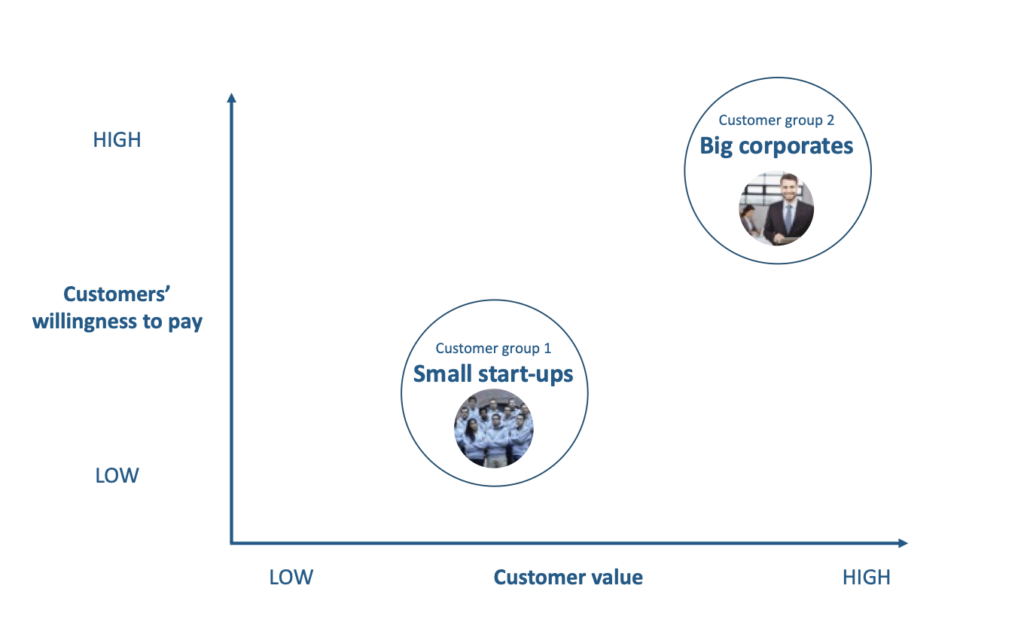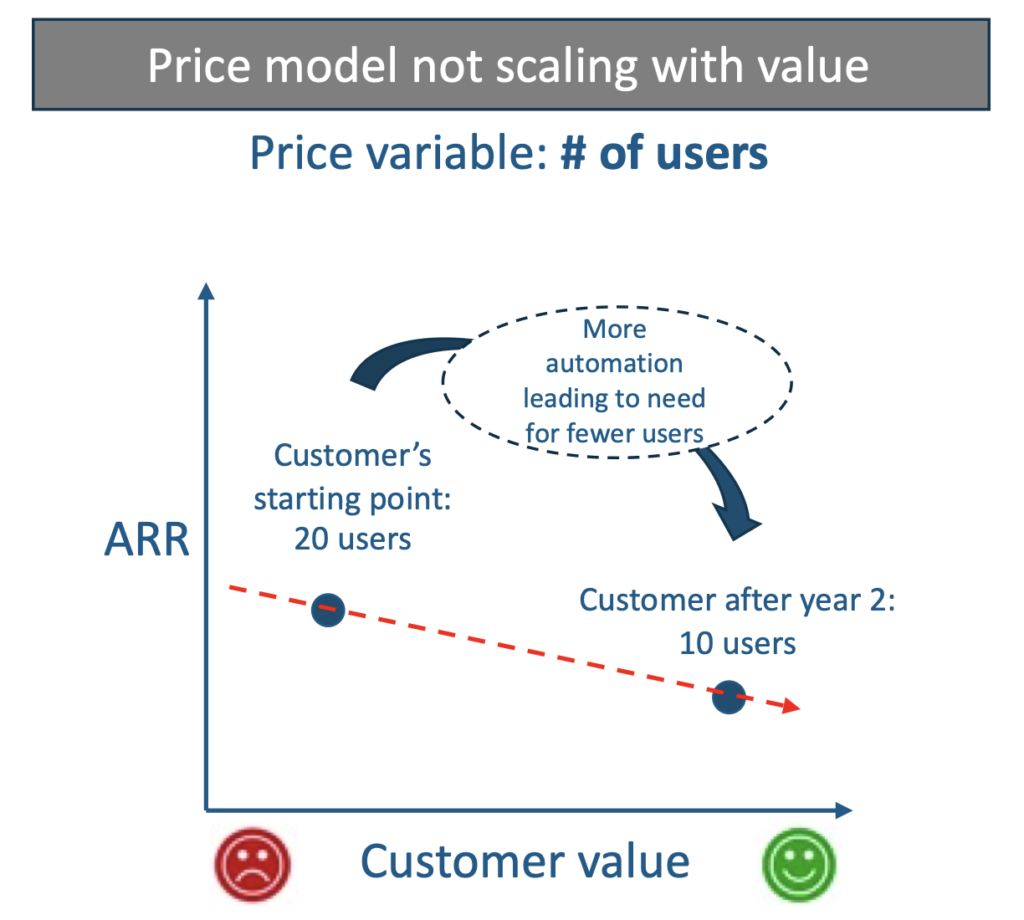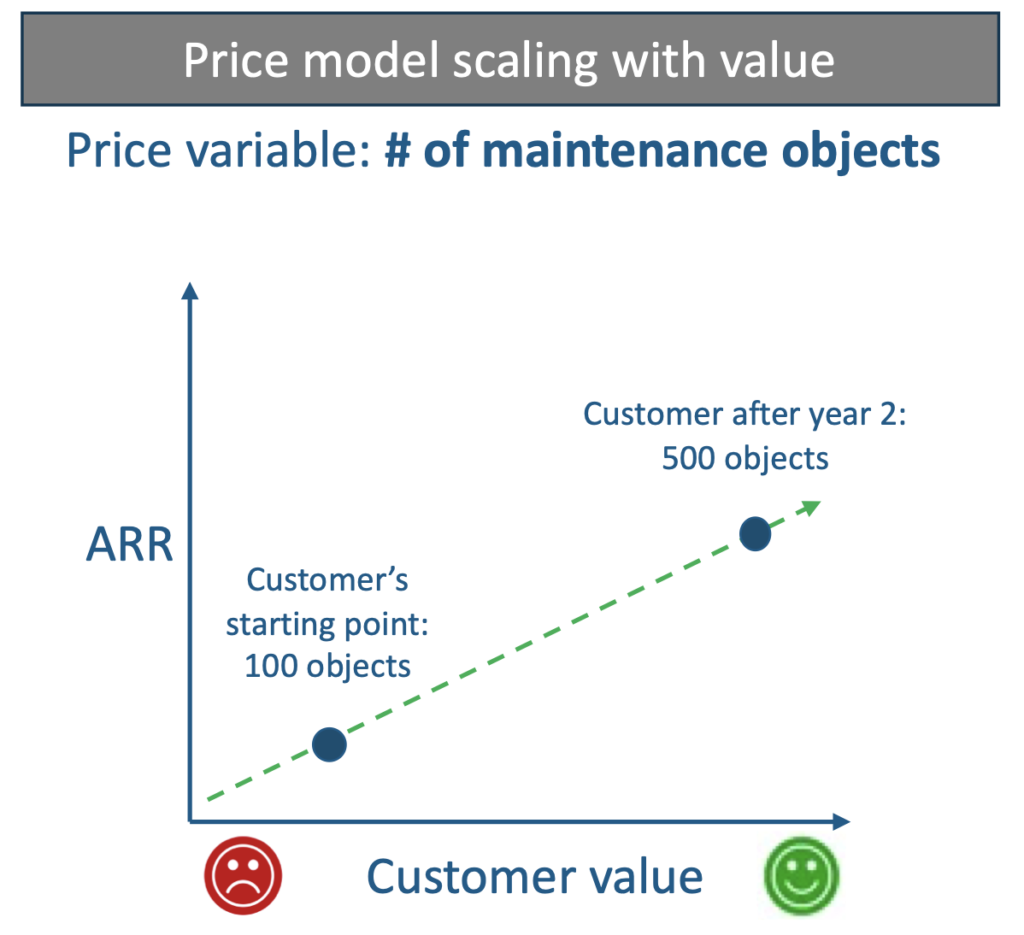5 steps to implement a new price model

Many software companies struggle to get their pricing right, and some also fear that a change of prices could result in churn and harm sales. Our experience, on the other hand, is the opposite. When implementing a value-based approach to pricing, you can attract new customers and grow and retain your existing ones. This article outlines five simple steps to get you started with a value-based price model.
Why a value-based pricing model?
As our previous blog post described, our preferred approach to pricing is to use a value-based price model. We recommend this model because you can lower the hurdle for new customers to start using your product and scale with your existing customer base over time.
Our experience in working with software pricing goes many years back. In the last year alone, our operational excellence team in Viking Venture has completed seven pricing projects together with our portfolio companies. When working with many software companies on pricing, we can create a playbook that we continuously develop as our approach improves.
The most important steps to creating a value-based price model:
- Segment your customers – do not price on the average customer
- Understand what value you provide to calibrate your price point and package your offering
- Find the proper value driver(s) to include in your price model
- Analyze switching costs for existing customers to understand pricing power and hurdles for new customers
- Understand the customers’ alternatives
1: Segment your customers – do not price on the average customer
The first step in creating a value-based price model is to understand if you have certain customer groups who experience different value from your product. It is essential to understand the different customer segments as you do not want to end up in a situation where you price your product based on your “average” customer.
Imagine you serve two customer groups: Small start-ups and big corporates.

Both customer groups use your product, but the value they get from using it differs greatly. The smaller start-up in this example receives considerably less value than the big corporate, which again says something about their willingness to pay.
Your price model needs to take these different groups into account. If you, in this example, price on the “average” customer, setting a price above what the small start-ups could be willing to pay and below what the big corporates could be willing to pay, you will be too expensive for the small start-ups. Also, you will leave a lot of money on the table from the big corporates.
After understanding the different types of customers you serve, you can move on to understanding the actual value these groups of customers get from using your product.
2: Understand what value you provide to calibrate your price point and package your offering
You should seek to understand the value each customer segment gets from using your product. Subsequently, this understanding will help you calibrate your absolute price point and package your offering in a suitable way for the different customer segments.
We typically divide customer value into revenue gain, cost reduction, and emotional gain:
1. Revenue gain: Can the customer earn more revenue by using your product?
2. Cost reduction: Can customers reduce their costs by using your product?
3. Emotional gain: Can the customer get intangible value from using your product?
What type of value you provide differs from one software company to another. We often see that software companies create value in all three categories. The perceived value also could depend on the type of persona of the customer. For example, the CEO could be most interested in how the software could help them generate increased revenue. Whereas the CFO could see more value in how the software could help reduce costs. In contrast, the end-users could be most interested in the more emotional gain. Like how they could reduce stress in their daily lives through the software.
We typically start with an internal workshop to brainstorm the value the customers get from using the product. After that we verify those hypotheses by talking to customers. It is difficult, if not to say impossible, to get to the correct answer. However, you should seek to understand if your product is worth, say, 1000 EUR per year or 1m EUR per year.
Once you have understood the value the different customer segments get from using your product, you can use this insight to set the right price point. As well as packaging your product in a way that matches the value they get.
3: Find the proper value driver(s) to include in your price model
A value-based price model should consist of at least one variable that directly correlates with the value the customer gets from using your product. This third step aims to find that variable.
Let us use an example to clarify. Imagine a software company providing a solution that helps companies maintain industrial assets. The company has historically used “number of users” as its price variable. Using the number of users as a price variable may make intuitive sense. However, in this example, the variable negatively correlates with customer value, as seen in the figure below.

The customer in the example starts with 20 users but only needs ten users after optimizing their processes using the software, leading to a lower ARR for the software provider. As a result, the software providers create more value for the customer but gets paid less.
In this example, a better proxy for customer value could be the “number of maintenance objects” added to the software. The more objects the customers adds to the software, the higher price they pay (and the other way around), as seen from the figure below.

Using the right pricing variable has two effects. First, you will be able to scale with the customers over time. Moreover they get more and more value from using your product. Secondly, you could lower the barrier for new customers to use your product and potentially increase conversions in your sales process.
The best way to find the right variable is to perform internal and external interviews. The interviews will help you understand what drives customer value. If you, for instance, figure out that you save your customers 1 000 EUR on every project they run through your software. Then «the number of projects» could be used as a pricing variable.
4: Analyse switching costs for existing customers to understand pricing power and hurdles for new customers
The fourth step is an exercise to understand how difficult or easy it is for your customers to switch to another provider. The purpose of this exercise is twofold. Firstly, to understand the pricing power you have over your current customers. Secondly, to improve your new sales by discovering what hurdles your competitors customers face when they consider switching providers.
We do this by estimating the number of hours the customers need to switch to an alternative provider – both internal and external hours. Internal hours are hours spent internally at the customer, whereas external hours are hours provided by external consultants etc.
Below is an example showing the number of hours needed for a typical software company customer to switch to another provider.

You should not misuse your pricing power – doing so could lead to adverse long-term effects. It is still essential to understand. If you, for example, find out that the price your customers pay is far less than the value they receive. Then an understanding of switching costs could help you get some confidence before adjusting your prices.
5: Understand the customers’ alternatives
If you operate in a monopoly, you could price purely on value. However, your customers most often have some alternatives to using your software. This step aims to understand your customers’ options and utilize this insight to verify that you can price on value and calibrate your price point.
Imagine you have a competitor offering the same type of customer value as you do. If the competitor charges a flat price for their product independent of customer value, it will be difficult for you to scale with value, as shown in the figure below.

The less differentiated your product is, the more you need to look at your competitors’ prices when deciding on your price model. You could also use your insight from the switching cost analysis and an assessment of your competitors’ prices to assess your pricing power. As shown in the below figure.

Create your value-based pricing model
When you have performed the analyses in the five steps above, you should be able to create a value-based price model in line with the findings. Remember that you must balance perfection with ease of communication for the customer. Suppose you find a variable that correlates perfectly with customer value. However, it is impossible for the customer to understand. then it is probably not a good price model. For many customers it is also important that the price model is predictable. As they should be able to calculate how much they need to pay over the next year/years.
Test, test, test
Once you have agreed on a new or adjusted price model, the best way to validate how well it works is to test it on existing and new customers. Additionally, you should think about pricing in the same way you think about your product. It is a continuous exercise that you should gradually improve and optimize over time.
Conclusion
To summarize, you should seek to use a value-based price model, and you can follow these five steps to get going:
- Segment your customers – do not price on the average customer
- Understand what value you provide to calibrate your price point and package your offering
- Find the proper value driver(s) to include in your price model
- Analyze switching costs for existing customers to understand pricing power and hurdles for new customers
- Understand the customers’alternatives
Download our pricing playbook
With our Pricing Playbook, you’ll gain the knowledge and insights needed to construct a value-based pricing strategy that resonates with the value you provide to your customers.
Join other software companies
Sign up for our newsletter to get valuable insights and the latest perspectives on how Nordic software companies can scale faster. Learn how to improve sales processes, develop your management team, optimize pricing and accelerate through acquisitions.